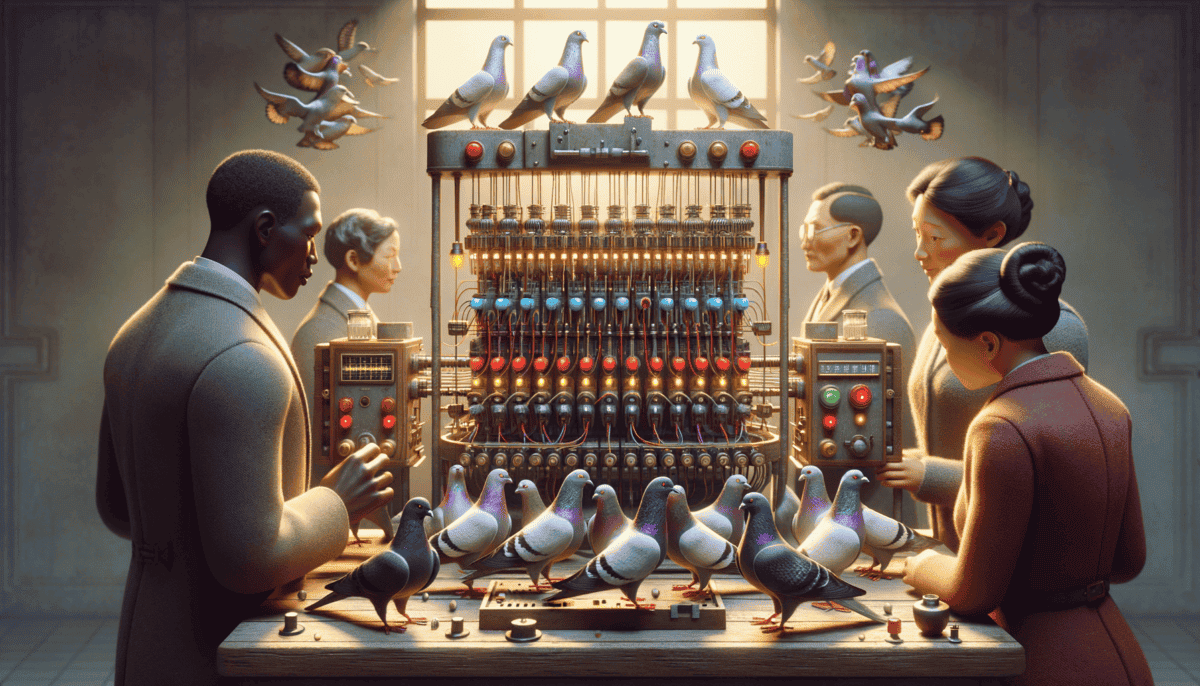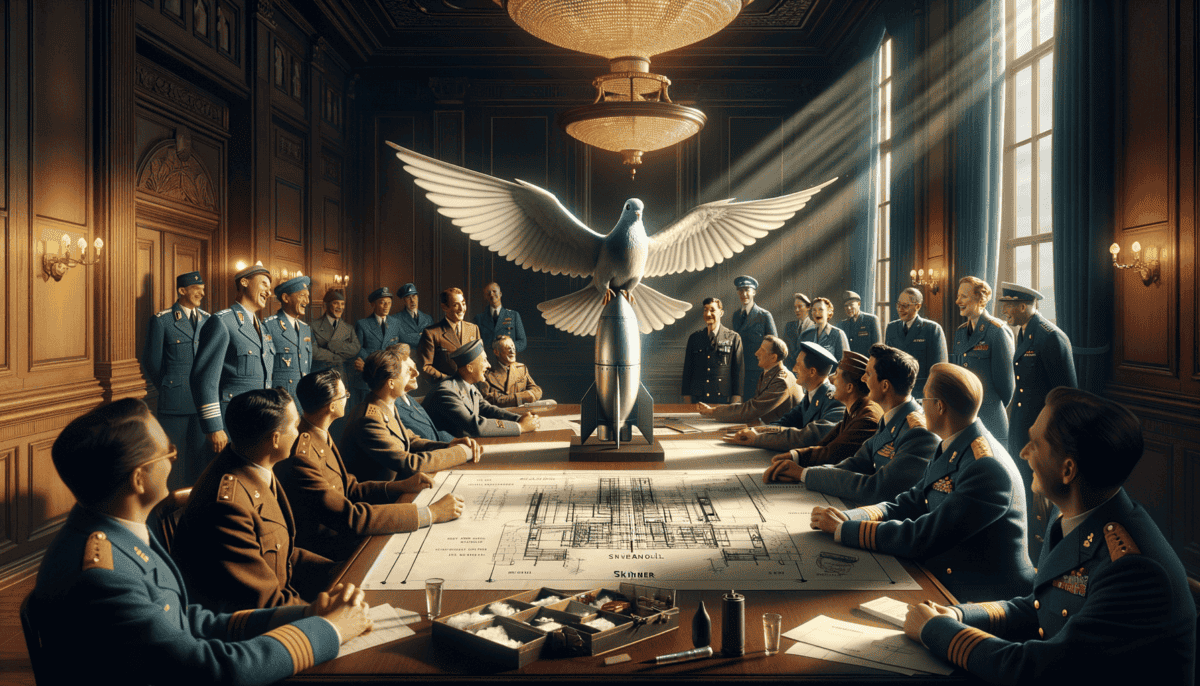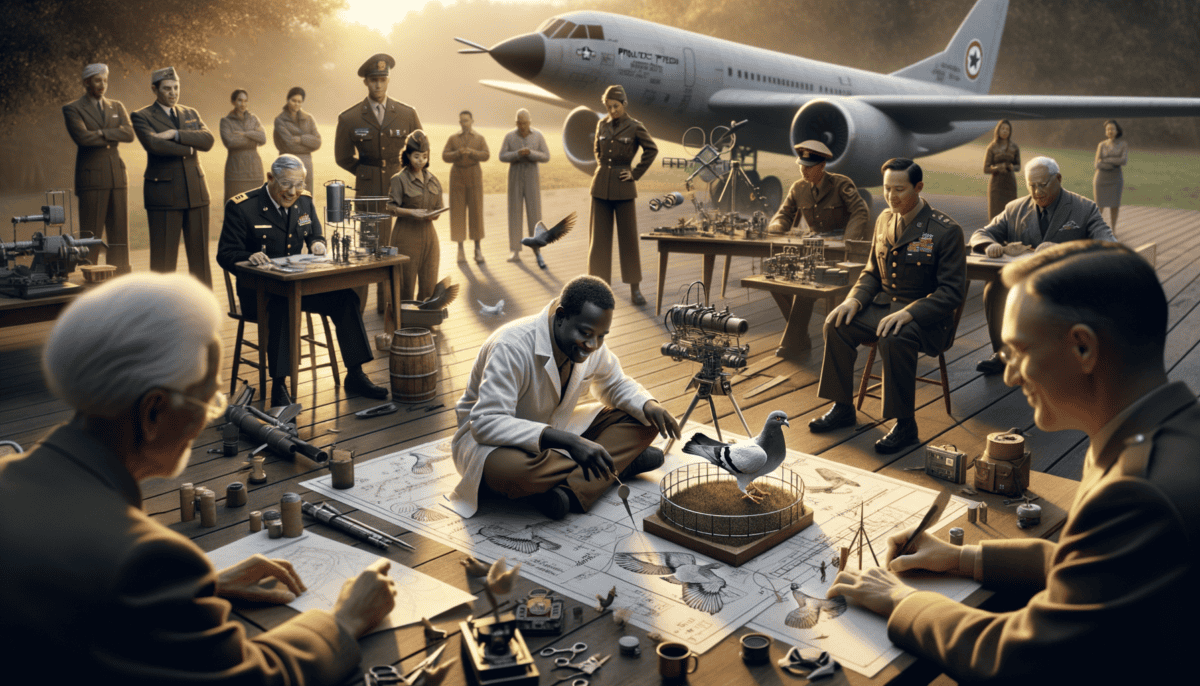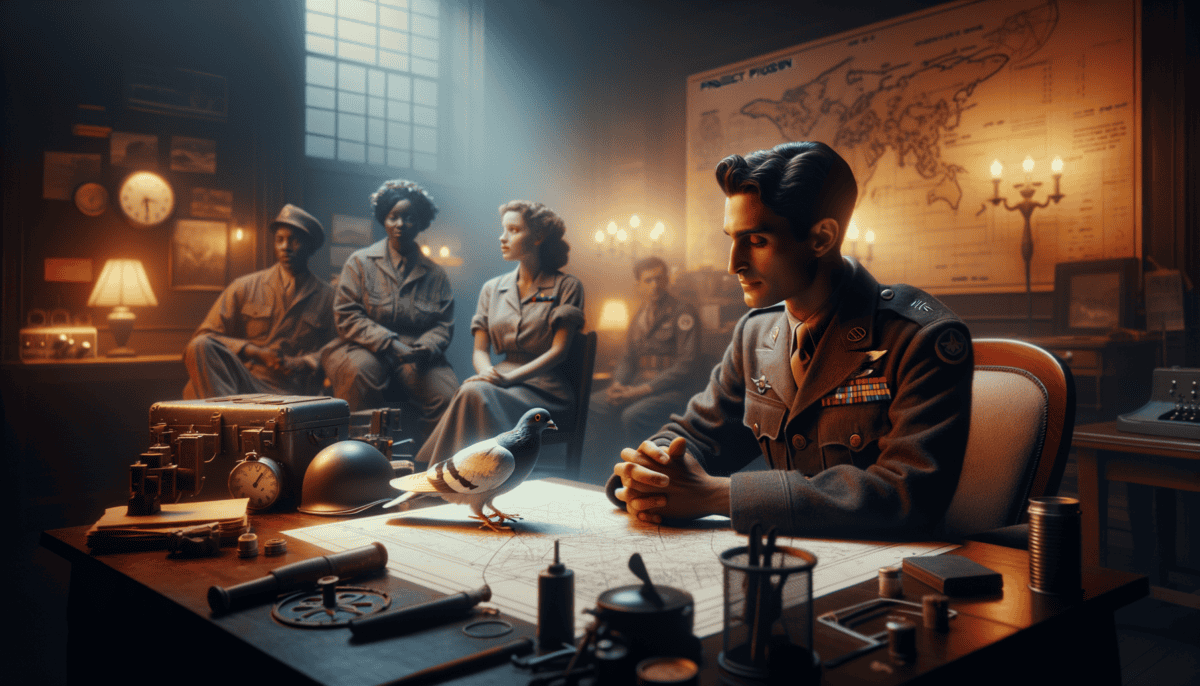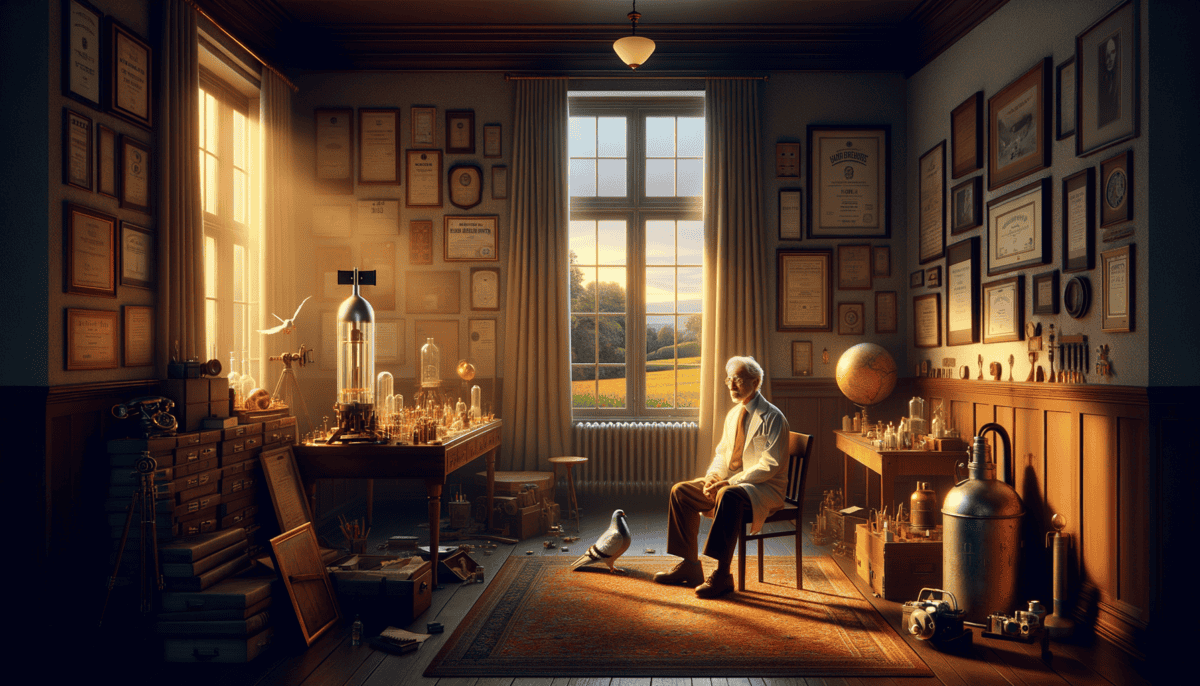The Unexpected Recruit
Dr. B.F. Skinner looked out his window at Harvard University one sunny morning in 1942. The news from the war wasn't good. American pilots were having trouble hitting their targets with bombs.
"There has to be a better way," he said to himself, watching a pigeon peck at breadcrumbs on the sidewalk below.
That's when it hit him – an idea so crazy it just might work!
Dr. Skinner jumped up from his desk and rushed to his notebook. He started writing fast:
“What if we could teach pigeons to guide missiles? They’re smart birds. They can learn patterns. Maybe they could help our pilots!”
He knew most people would laugh at using birds to fight in World War II. But Dr. Skinner had studied animals for years. He knew pigeons were special.
"Come here, little friends," he said softly, approaching some pigeons in the courtyard. "Would you like to help win the war?"
The birds cocked their heads and cooed. Dr. Skinner smiled. He had seen pigeons do amazing things before:
• Find their way home from very far away
• Remember complex patterns
• Learn new behaviors quickly
• Work for food rewards
• Stay focused on tasks
Back in his lab, Dr. Skinner set up some simple tests. He put a pigeon in a special box with a little screen. When the bird pecked at certain shapes on the screen, it got food.
"Good bird!" he said, watching one pigeon learn the task in just minutes. "You're going to help save lives."
But training birds was just the start. Dr. Skinner needed to build something that had never been made before – a way for pigeons to sit inside missiles and help steer them!
He drew pictures of his idea:
Special screens showing the target
A way for the bird’s pecks to control the missile
Some of his friends at Harvard thought he was silly. "Birds flying missiles? That's crazy!" they said.
But Dr. Skinner didn't give up. He knew sometimes the craziest ideas turned out to be the best ones.
"Just wait and see," he told the doubters. "These pigeons will surprise you."
Every day, more pigeons learned to peck at targets. They got better and better. Dr. Skinner wrote excited letters to the military:
I have found a way to make bombs hit their targets more accurately. It may sound strange, but please let me show you what my pigeons can do…”
At night, Dr. Skinner worked late in his lab. The soft cooing of sleeping pigeons kept him company as he built his first test system. He knew he had to prove his idea could work.
"Tomorrow is a big day, my feathered friends," he whispered to the birds. "Tomorrow we show everyone what you can do."
The pigeons settled into their cages, ready for whatever challenges came next. They didn't know they were part of one of the strangest and most creative military projects ever tried. They just knew they had a job to do, and they were ready to do it.
As Dr. Skinner turned out the lights, he smiled. Sometimes the best solutions come from unexpected places – or in this case, unexpected recruits with wings!
Training Feathered Soldiers
The morning sun peeked through the windows of Dr. Skinner’s special training room. Dozens of curious pigeons watched as he set up their new training equipment.
“Today we start something big,” he told his feathered students. “We’re going to learn how to fly missiles!”
First, he needed to choose the best birds. He watched them carefully and made a list of what made a good “pigeon pilot”:
• Good at staying focused
• Calm under pressure
• Strong pecking skills
• Eager to work for food
“Come here, Number 47,” Dr. Skinner called to a speckled grey pigeon. “Let’s see what you can do!”
He placed the bird in front of a special screen. Pictures of boats, buildings, and bridges flashed by. When Number 47 pecked the right target, a tiny door opened with a treat inside.
“Wonderful!” Dr. Skinner clapped as Number 47 got it right again and again. “You’re a natural pilot!”
But not everyone believed in the pigeon pilots. Dr. Wilson, another scientist, came to visit the lab.
“Birds controlling missiles?” he laughed. “That’s silly!”
“Watch this,” Dr. Skinner said with a smile. He showed how Number 47 could keep pecking a moving target, never missing once.
Dr. Wilson’s eyes got big. “Well, I’ll be…” he whispered. “Maybe it’s not so silly after all.”
Next, Dr. Skinner had to build special equipment for the birds. He made tiny “cockpits” where they could sit and see screens. When they pecked the middle of the target, lights would flash to show they were on track.
“Good job, team!” he said as three pigeons worked together in their training box. “You’re becoming real soldiers now!”
The training got harder each day. The targets moved faster. The pictures got trickier. But the pigeons kept learning and getting better.
– Track moving ships
– Find camouflaged buildings
– Stay focused even with loud noises
– Work in teams of three
Dr. Skinner wrote in his notebook every night:
“Day 45: The pigeons continue to amaze me. They learn faster than any animal I’ve ever studied. They might really help us win this war!”
He built the first real guidance system with three small windows. Each window had a screen showing the target. Three pigeons would work together, pecking to keep the target in the center.
“What do you think of your new office?” he asked Number 47, who was trying out the system. The pigeon cooed and pecked perfectly at the target.
Even on weekends, Dr. Skinner came to train his birds. He knew every minute counted. The war wasn’t waiting, and his pigeons needed to be ready.
“Soon,” he told his feathered team, “you’ll show everyone what you can do. You’ll help save lives and make history!”
The pigeons fluttered their wings and cooed softly. They didn’t know about the war or about making history. They just knew they had a job to do, and they were getting better at it every day.
Science Meets War
The big day had come! Dr. Skinner stood nervously in front of a room full of military officers. His best pigeon pilots – Number 47, Blue Wing, and Speckles – waited in their special training box.
“Gentlemen,” Dr. Skinner said, trying to sound brave. “I’d like to show you something amazing!”
General Thompson crossed his arms. “Birds guiding missiles? This better not be a joke, Dr. Skinner.”
“Just watch,” Dr. Skinner smiled. He turned on the screen showing a picture of a battleship.
The three pigeons got right to work! They pecked at the screen, keeping the ship perfectly centered. Their little beaks tapped steadily as the target moved back and forth.
“Amazing!” whispered Captain Roberts. “They’re working together like a tiny bird team!”
But there were big problems to solve. The guidance system needed to be stronger to survive inside a real missile. And the pigeons had to work in the dark, with lots of noise and shaking.
Dr. Skinner and his team worked hard to fix these problems:
• Added special lights for dark times
• Built better seats for bumpy rides
• Created backup systems for safety
• Made sure the birds stayed calm
“What if the birds get scared?” asked Lieutenant Davis during a test.
“Watch this!” Dr. Skinner turned on a loud engine noise. The pigeons kept working, not scared at all!
Some days were hard. Once, the power went out during a big test. Another time, a screen broke right before an important demonstration.
“Maybe we should stick to regular missiles,” grumbled Colonel Peters.
But Dr. Skinner didn’t give up. He knew his birds could do it. He worked late every night, making the system better and better.
“Look how accurate they are!” he showed the officers. The pigeons hit their targets almost every time, way better than the regular missiles could do!
“I’ve never seen anything like it,” admitted General Thompson. “These birds might really work!”
The team celebrated small wins. Like when Blue Wing set a new record for accuracy. Or when they finally made a system that could handle rough weather.
Dr. Skinner’s notebook filled up with good news:
But some military leaders still weren’t sure. They had never used animals to guide weapons before. It seemed too different, too strange.
“Trust the science,” Dr. Skinner told them. “These pigeons are smarter than you think!”
Number 47 cooed softly from the training box, as if agreeing. The little bird had no idea it was helping to change history. It just knew it had a job to do, and it was doing it well.
As the sun set on another busy day, Dr. Skinner patted the training box. “Tomorrow’s another chance to prove ourselves,” he told his feathered team. “And we’ll be ready!”
The Critical Test
The morning sun peeked through the laboratory windows as Dr. Skinner checked on his pigeon team. Today was the biggest test yet!
“Good morning, champions,” he whispered to Number 47, Blue Wing, and Speckles. The birds cooed softly in their special boxes.
Sarah, Dr. Skinner’s best helper, rushed in. “They’re here early! The generals are already in the testing room!”
“Deep breaths,” Dr. Skinner told himself. He carefully picked up the pigeon guidance system. It had taken months to build, and today it had to work perfectly.
“Remember team, just like we practiced,” he whispered to his birds. “You can do this!”
The testing room was packed with important people. General Thompson sat in front, his face serious. Next to him, Admiral Jones played with his hat, looking bored.
“Dr. Skinner,” General Thompson said, “show us what these birds can really do.”
Dr. Skinner’s hands shook a little as he set up the equipment. The birds waited quietly in their special spots, ready to work.
Second Test: Keep working when it’s noisy
Third Test: Find the target in bad weather
Sarah turned on the big screen. A picture of a battleship appeared. The room got very quiet.
“Begin test one!” called General Thompson.
The pigeons jumped into action! Their little beaks tapped the screen, keeping the ship perfectly centered.
“Look at that accuracy!” whispered an officer. “They’re better than our best machines!”
But then… BOOM! A loud noise shook the room. It was part of the test, but Number 47 jumped in surprise.
“Keep going,” Dr. Skinner whispered. “You can do it!”
The brave birds didn’t quit! They kept working, even when more loud noises came. Even when the lights flickered. Even when cold air blasted into the room.
Admiral Jones leaned forward in his chair. He wasn’t looking bored anymore!
“Now for the final test,” General Thompson announced. “Show us how they handle rough weather.”
Sarah turned on giant fans. The whole system shook. Rain splattered against the screens. But the pigeons kept working!
“Remarkable,” Admiral Jones stood up. “Simply remarkable!”
The room burst into applause. Dr. Skinner’s heart felt like it might burst too! His birds had done it!
• Perfect accuracy on all targets
• Stayed calm during loud noises
• Worked great in bad weather
• Impressed the military leaders
• Proved the system could work
“Dr. Skinner,” General Thompson walked over with a smile. “I think we need to talk about the next phase of Project Pigeon.”
Sarah gave the birds their favorite treats. They had earned them! Number 47 looked especially proud, puffing up his chest feathers.
“Good job, my friends,” Dr. Skinner told his feathered team. “You just made history!”
As the sun set that evening, Dr. Skinner wrote in his notebook:
The birds cooed softly in their boxes, ready for whatever new adventures tomorrow might bring.
Between Hope and Doubt
Two weeks after the big test, Dr. Skinner paced in his office. The pigeons watched him from their comfy cages.
“Why haven’t they called?” Sarah asked, giving fresh water to Blue Wing.
“Big decisions take time,” Dr. Skinner said. But his tummy felt funny with worry.
The phone finally rang!
“Dr. Skinner?” It was General Thompson. “We need to talk. Can you come to Washington?”
The next morning, Dr. Skinner sat in a big room with lots of important people. Some looked happy, others looked worried.
“Your birds did great,” Admiral Jones said with a smile. “But we have some problems to fix.”
General Thompson pulled out a long list:
• The guidance box is too heavy
• We need more trained pigeons
• The system costs too much
• Other new inventions are coming
• Some people still don’t believe it will work
“We like your ideas,” a scientist named Dr. Roberts said. “But maybe we should wait.”
Dr. Skinner’s heart felt heavy. He thought about Number 47, Blue Wing, and all his brave birds. They had worked so hard!
Back at the lab, Sarah tried to cheer him up. “Maybe they’ll change their minds?”
The pigeons cooed softly, as if they were trying to help too. Number 47 pecked at his favorite treat, but even he seemed less bouncy than usual.
“We’re not giving up,” Dr. Skinner told his team. “We’ll keep working and make everything better!”
Days turned into weeks. Dr. Skinner and Sarah worked extra hard. They made the guidance box lighter. They trained more pigeons. They fixed every problem they could find!
But then more bad news came. The war office had picked a different way to guide missiles. They were using new machines instead of birds.
“What happens now?” Sarah asked, her voice shaky.
Dr. Skinner looked at his faithful pigeon team. They had shown everyone how smart birds could be. They had done everything right.
“Now we learn something new,” he said. “Sometimes even good ideas need to wait for the right time.”
That evening, Dr. Skinner wrote in his notebook while the pigeons settled down for the night. The sun was setting, painting the lab in soft orange light.
Number 47 cooed softly from his perch. Dr. Skinner smiled.
“You’re still heroes,” he told his birds. “And someday, everyone will know about the brave pigeons who almost helped win the war.”
The lab grew quiet as darkness fell. But in Dr. Skinner’s mind, new ideas were already starting to grow. Maybe the pigeons could help people in different ways. Maybe this was just the beginning of something even bigger! ⭐️
Legacy of the Unexpected
Twenty years after Project Pigeon ended, Dr. Skinner sat in his cozy study. On his desk sat a special photo of Number 47 and Blue Wing.
“Grandpa, tell me about your special birds again!” his little granddaughter Emily bounced on his knee.
“Well, sweetheart, once upon a time, I trained pigeons to be heroes,” he smiled, remembering those exciting days.
The world had changed a lot since Project Pigeon. New computers did the jobs they once hoped pigeons would do. But Dr. Skinner knew his birds had helped in other special ways.
Scientists now used Dr. Skinner’s training ideas to help lots of animals. Some helped disabled people. Others found lost hikers. Many saved lives!
“What happened to Number 47?” Emily asked, touching the photo.
Sarah, now a famous animal teacher herself, visited Dr. Skinner that afternoon. Her gray hair shined in the sunlight.
“Remember how worried everyone was about using birds?” she laughed.
“Now look!” Dr. Skinner smiled. “Animals help people everywhere. Project Pigeon showed what was possible!”
They looked through old pictures and papers from the project. The government had finally told everyone about the secret pigeon plan. People were amazed!
• Animals can learn amazing things
• Never give up on new ideas
• Sometimes “silly” plans work best
• Being different is good
• Small friends can solve big problems
Dr. Skinner opened his old notebook. The pages were yellow now, but the words still made him smile.
“Dear Number 47,” he read. “Today you showed us that anything is possible if we believe and work hard.”
“You were right all along,” Sarah said softly. “The pigeons were special.”
That evening, Dr. Skinner watched pigeons play in his backyard bird feeder. They weren’t military heroes like Number 47, but they reminded him of those brave days.
“Look, Emily!” he pointed. “Those pigeons are just as smart as our Project Pigeon friends. They just haven’t had the chance to show it yet!”
Dr. Skinner hugged his granddaughter. The spirit of Project Pigeon lived on in her excitement. Maybe she would discover new ways for animals to make the world better!
“Remember, Emily,” he whispered, “the best ideas often come from unexpected places – even from little pigeons who dream of being heroes.” ⭐️
As the sun set, Dr. Skinner thought about all the amazing things that had started with one simple idea: pigeons could be heroes. And even though Project Pigeon didn’t work exactly as planned, it had changed the world in wonderful new ways.
The pigeons cooed softly in the garden, just like Number 47 used to do. In their gentle sounds, Dr. Skinner heard the echo of a brave dream that had opened doors to endless possibilities.


